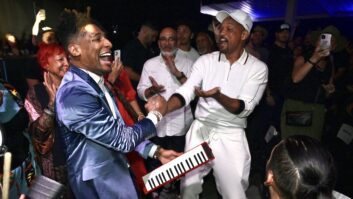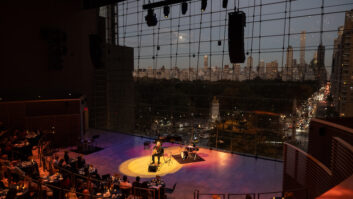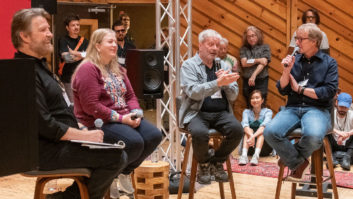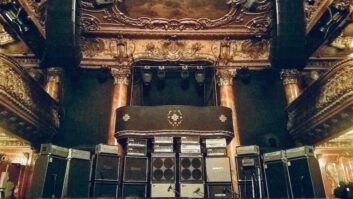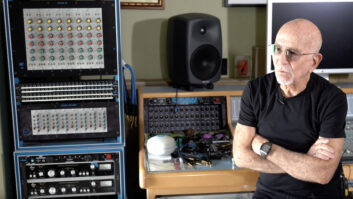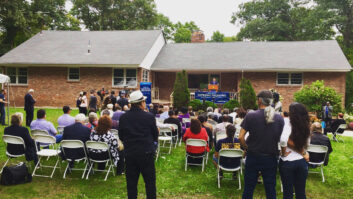Roy Haynes is a something of an under-appreciated gem amid the treasure trove of America’s great jazz veterans. The 73-year-old drummer is not particularly well-known as a leader, but that was hard to believe in Manhattan last August when Haynes had the spacious Birdland club packed to the walls. The diminutive, shaven-headed Haynes, who began his musical career in 1944, proceeded to play with the verve of a man one third his age, driving and inspiring his musicians-including the great young saxophonist David Sanchez-to one blazing peak after another. Along with his astonishing jazz chops, Haynes plays and leads with a punch, showmanship and power that brings to mind the primal, youthful exuberance of great rock drummers.
Though he’s dabbled in jazz-rock, most notably with his ’70s group the Hip Ensemble, Haynes fundamentally remains a jazz purist. When told that his playing appears to have the youthful spirit of the best of rock drumming, Haynes replies with a hearty laugh, saying “I’m sorry to hear that!” However, he’s heard it before. “When we play places where there’s a younger crowd,” he adds, “the first thing some of the ladies comment on is the ‘energy’ that I play with. But it’s how you do the energy; it’s not just pounding your instrument. There may be a lot of power in my playing but it is still all about trying to draw a musical sound out of the drums.”
Haynes’ commanding talent and presence make perfect sense when one considers that he participated directly in some of the best of the latter half of 100 years of jazz. The man has, after all, backed Bud Powell, Miles Davis, Thelonious Monk, Eric Dolphy, Stan Getz and Gary Burton, and he did extensive work with Charlie Parker (1949-52), John Coltrane (as the regular substitute for Elvin Jones, 1961-65), Sarah Vaughan (1953-58) and Chick Corea. Guitarist Pat Metheny sums up Roy Haynes well in the liner notes to Praise, Haynes’ most recent recording: “He has a depth and a listening sensitivity that allows him not only to play beautifully every time but to make the musicians the beneficiaries of his musical wisdom, always inspiring them to new heights. The many nights I’ve played with Roy remain among the highlights of my life as a musician.”
Praise was recorded in three days in May of 1998 at Brooklyn’s Systems Two studios with Haynes producing; the engineer was New York jazz specialist A. T. Michael MacDonald. The swingin’ date included sax stars Sanchez (tenor) and Kenny Garrett (alto and tenor), Roy’s son Graham Haynes on fluglehorn and cornet, Haynes’ longtime pianist David Kikoski, bassist Dwayne Burno and percussionist Daniel Moreno. If Haynes had had his own way, the record would’ve been cut during a live club date. “I’m not that comfortable in the studio,” Haynes explains. “Headphones and isolation booths are not conducive to the feeling I’m after. I want eye contact; I give a lot of cues.” However, the record company wanted a studio session, so to approximate the cherished live feeling, Praise was cut with almost no overdubs, and the only musician who worked in an isolation booth was bassist Burno.
MacDonald never even considered putting Haynes in a separate room. “Roy Haynes in a drum booth would’ve been a disaster; he would’ve blown out the room,” he says. “All I did was place some gobos around him to keep the horns out of his mics, rather than try to keep him out of the other mics-the bleed of a great drummer like Roy Haynes is a part of the sound of a good jazz date.”
Haynes was set up in a corner of Systems Two’s 50×40-foot main room, which has a 26-foot ceiling. The rest of the musicians were close by in a semi-circle. “It’s as close to a live date as we could get, very straight ahead,” Haynes explains. A chief concern was getting Haynes’ signature “snap, crackle and pop” drum sound right. “I like a bright sound; everything now is geared toward more of a funk drum sound,” the drummer complains. But getting Haynes’ drum sound right really isn’t much of a challenge according to engineer MacDonald: “He could make any drum set sound amazing because he has such a wide dynamic range, and is such an explosive, physical player.” For the sessions, Haynes brought in his own his drum set, which his son Craig tuned in about 20 minutes.
Systems Two’s big, high-ceilinged room was a significant factor in the recording of Praise. “The studio is a converted movie theater, and its got just the right mix of diffusion and absorption, unlike some of the big Manhattan rooms where the sound just dies,” MacDonald says. “You can take off the headphones and hear everything in Systems Two. In fact when we cut Charlie Parker’s “My Little Suede Shoes” [the original of which Haynes recorded with Bird nearly 50 years ago] as a duet with only Haynes and Kenny Garrett, we didn’t use headphones, just the room’s acoustics.”
Haynes’ drum set was miked primarily with overheads. “I always start with the overhead mics and then close-mic all the drums, but tuck the close mic sounds into the overhead mix,” MacDonald says. “If you were to solo my kick or snare track they might sound unimpressive. But when you hear it all in concert with the overhead mics it suddenly makes sense.” The overheads were Schoeps CMC 5s; the kick an EV RE20; snare was the standard SM57; high-hat an AKG 414; and the toms Neumann U87s.
MacDonald says he prefers to avoid using equalization. “I feel EQ creates as many problems as it solves. I prefer to adjust the frequency curves with different mics and their placement. When you add high-end EQ you get a slight delay from the capacitors storing energy. It’s very subtle, but cumulative-when you EQ in tracking, mixing and mastering it builds up and you get a time smear. Plus with something as harmonically complex as a piano, you can easily destroy that delicate harmonic balance with the twist of a knob. When I use EQ it is only as a last resort, and usually it will be cuts rather than boosts.” The only EQ used for the entire date was a little notching out of the drums. “You get a pile-up with multiple mics in the midrange, so I sucked out a couple of dBs at the 200 to 400Hz range,” MacDonald explains.
Haynes bowed to MacDonald regarding the mic placement and choice. However, when it came to balance the drummer was more involved. “Roy wants things very aggressive,” MacDonald says. “The drums are very forward, and the cymbals are brought back down into the drums. Getting that balance right is more important than the mic choice. We could’ve put all SM57s on Roy’s drums, and if we balanced it right it would’ve sounded amazing.”
The rest of the players were tracked using mostly vintage mics. RCA 44s were used on Graham Haynes’ fluglehorn and cornet because “they don’t give you anything effective above 8 to 9 kHz,” MacDonald says. “That is perfect for a fluglehorn or cornet, because I don’t want to hear 15 kHz; it’s just spit and noise. When we hear a horn live we’re not 15 inches but 15 to 20 feet away, and that stuff gets lost. So the RCA 44s give you a natural presentation.”
Saxmen Sanchez and Garrett used Neumann U47s. “They have the perfect coloration for saxophones,” says MacDonald. “You simply put them in the right place and hope the player will reasonably stay in that sweet spot.”
Systems Two’s piano is a highly pedigreed concert grand, Steinway number 385, which was the house piano at Carnegie Hall for many years. However, in MacDonald’s estimation some of the upper registers are a tad brittle. “The Sony 37s have kind of a chunky sound, and they smoothed out the brittle registers. For another piano I would’ve used different mics.”
Praise, like most jazz dates these days, was cut on a tight schedule, which was just fine. “Two takes was the norm, with the maximum being three,” MacDonald notes. “The caliber of the musicianship was so high that we didn’t need more takes. I think that was also part of Roy’s approach as producer: He didn’t want people to think too much or go through take after take.” The last track, Haynes’ drum solo “Shades of Senegal,” was cut in one pass. “Roy kept saying that he was thinking about a drum solo piece, but that he wasn’t sure exactly what he would do. But he did it once and that was it, and it was absolutely brilliant. I have to think that the old master knew what he had in mind all along,” says MacDonald admiringly.
The Praise sessions were tracked to a Mitsubishi X-800 32-track digital because it “was in the room and plugged in and it sounded great.” The console was an Otari Concept 1 analog automated board that MacDonald says was “transparent with a lot of punch.” The analog-to-digital converter was a Prism AD 124. The recording was mixed in two days to a Sony PCM-9000 magneto-optical drive at Systems Two and mastered using Sonic Solutions at MacDonald’s AlgoRhythms mastering room in Manhattan. Monitors for tracking and mixing were Genelec 1031As. MacDonald used no compression and one reverb unit “very slightly on everything, an old Klark Teknik DN780, an ’80s-era machine that people love so much you never see them on the used market.”
Praise was a dream job for MacDonald: “I’ve worked with a lot of famous jazz musicians,” he says, “but I can’t recall working with anyone with so much life, energy and animation, yet so much focus. I think everyone on the date was inspired to play a little bit better than they normally might. Meanwhile the whole thing was on Roy’s shoulders, and he’s just going along telling jokes and goofing around. That is until they sat down to play-then it was all business. I told Roy I felt privileged to be a part of this record; I would’ve done it for nothing.”

